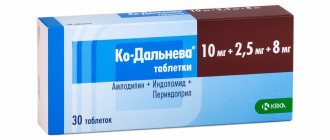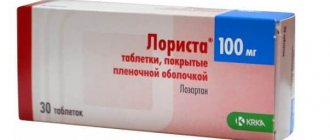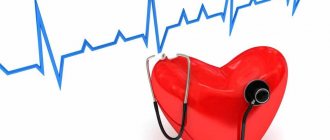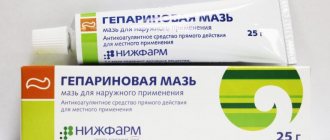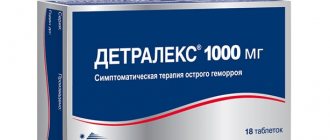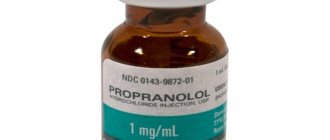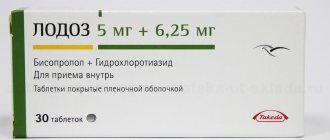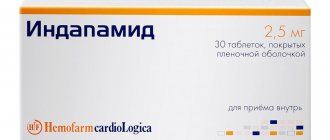Author of the article
Anatoly Shishigin
Reading time: 4 minutes
AA
If there is a need to remove excess fluid from the patient’s body, doctors recommend the diuretic Trifas. This drug successfully copes with urine excretion even in difficult cases when other diuretics are powerless. But despite this effectiveness, Trifas has a number of contraindications that must be taken into account before starting to take the drug on a regular basis.
General description of Trifasa
After entering the body through oral administration, Trifas has a very rapid diuretic effect that persists in the patient for 12 hours. An increased volume of urine excreted is observed even in cases where other diuretics are ineffective, which is often found in patients with diagnosed kidney failure.
Moreover, the effectiveness of the drug is so high due to reduced hypodynamics, which is caused by a decrease in the removal of calcium from the blood plasma and the elimination of problems with the water-electrolyte balance of the body.
Active substance
The active ingredient in the drug Trifas is torasemide, which is produced from sulfamonlanthranil acids. This diuretic is a loop diuretic, it retains all the qualities of this group and acts on the nephron through the lumen. There is a connection with the Na-K-Cl cotransporter (protein), which is located in the cell structure in the thick segments of the ascending type knees.
With this process, there is a strong suppression of Cl, K, and Na ions in the lumens of the renal tubules. This ensures that the kidneys excrete about 20% of sodium in a filtered state, which significantly reduces fluid reabsorption.
Torsemide has an intense effect on blood flow in the kidneys, increasing the production of prostacyclin and activating the kallikrein-kinin system. This action is typical for all loop diuretics used for problems with renal filtration in their glomeruli. The production of prostacyclin is necessary to relieve preload on the ventricle on the left side, as well as for the proper dilation of the veins.
Pharmacodynamics
The higher the dosage of Trifas, the more powerful and intense the diuretic effect. The peculiarity of the active substance lies in its antialdosterone effect, characterized by less loss of potassium ions than, for example, furasemide. The drug is unique in the absence of a rebound phenomenon, in which the reabsorption of sodium (ions) actively increases after stopping the medication. This effect is observed when taking many diuretics that activate the renin-angiotensin system.
More on the topic: How do diuretics work for weight loss?
When taken orally, Trifas is actively absorbed by the digestive tract, and there is no dependence on the presence of food or liquid in it. In blood plasma, the maximum concentration is observed after a couple of hours. The bioavailability of the drug is 91% positive. Almost 80% of the drug is excreted by the kidneys, the remainder is removed through the bile ducts. Half-life from the body occurs after 4 hours, and the period of time does not change even with problems in the functioning of the kidneys and their insufficiency.
Who is contraindicated for treatment?
Not everyone can take the drug Triphas; the instructions for use list conditions for which therapy is contraindicated.
Do not use:
- with hypersensitivity to torasemide and its derivatives in the past;
- with hypotension;
- with renal failure;
- with anuria;
- with serious liver dysfunction, including coma or precoma;
- when the volume of moving blood decreases;
- with reduced levels of sodium and potassium in the blood;
- with impaired urination due to an enlarged prostate gland;
- with excessive deposition of oxalates in the joints;
- with increased excitability and conductivity of the heart muscle;
- with disturbed acid-base balance;
- with anemia and low platelet counts;
- in cases of kidney dysfunction;
- in children under 12 years of age.
When is Trifas prescribed and how to take it?
Doctors prescribe the loop-type diuretic Trifas for the therapeutic treatment of high blood pressure, hypertension, edema due to kidney or liver failure, as well as acute left gastric failure.
The drug is started with a dosage of 2.5 mg per day. Blood pressure decreases gradually; after a week, positive changes are already noted, and after 12 weeks of regular use, maximum effectiveness is achieved. If an urgent need arises, the dose of the drug per day can be doubled, but only as prescribed by a doctor.
For persistent swelling of the patient, the recommended dosage is 5 mg per day. According to the doctor’s decision and the severity of the disease, this dosage can be increased, but not exceeding 20 mg of the active substance per 24 hours.
In case of kidney failure, the patient needs to take a quarter of a tablet, but if the urine produced is too little, then the dose of Trifas taken is increased to 200 mg per day. The medication is taken in the morning with a sufficient amount of water, without chewing. The course of treatment continues according to the doctor’s decision, depending on the severity of the disease.
Overdose
If the dose is exceeded due to a violation of the dosage taken, symptoms of overdose may appear:
- confusion appears in the patient's consciousness;
- the volume of urine released when the patient urinates greatly increases in a short time;
- there is a malfunction in the gastrointestinal tract;
- The pressure drops to the minimum normal level, or we go beyond its lower limits.
More on the topic: Is Trigrim a diuretic?
If an overdose occurs, therapy is needed to eliminate the symptoms. This is achieved by compensating for the loss of electrolytes and normalizing the water balance in the body. There is no special antidote to the diuretic Trifas, but if the level of potassium in the blood plasma has dropped significantly, it is necessary to restore its level to normal with potassium preparations.
Features of application
The instructions for use characterize long-term use of the drug "Trifas" as a condition that requires regular monitoring of the balance of electrolytes, especially potassium ions in the blood serum. Glucose, creatinine, uric acid and fats - all these indicators require measurement in order to promptly detect the development of diabetes. During treatment, it is necessary to monitor the patient's blood counts.
During pregnancy and lactation, it is better not to use the drug, since there is no reliable data on the safety of torasemide for a child.
The effect of the medication may reduce a person’s activity when driving a car and other mechanisms that require attention. Do not combine it with alcoholic drinks.
How to take Trifas during pregnancy?
There is no information about the effect of Trifas on the fetus and embryo in the cavity of a pregnant woman. In clinical trials on animals, the toxicity of torasemide was revealed to be of the reproductive type. The active substance is able to penetrate the placenta barrier, so for pregnant women this diuretic is applicable only in emergency cases and in the very minimum dosage.
Diuretics are not used in the typical therapeutic treatment of hypertension in pregnant women for the reason that they reduce the permeability of the protective barrier of the placenta and can damage the fetus with toxins. When treating pregnant women with the drug Trifas in cases of heart or kidney failure, special regular monitoring of hematocrit and electrolytes is required, and close attention is also paid to the developing fetus.
When breastfeeding, taking Trifas is contraindicated; if the need is urgent, feeding is stopped until the active substance is completely removed from the mother's body.
Reviews about the drug
Patients leave mostly positive reviews about the drug Trifas. But you can also find negative statements about the drug on the Internet. This is due to the fact that in the presence of severe edema, Trifas may be ineffective. In this case, the doctor must select medications for the patient for hypertension that do not contain torasemide.
Marina Ilyinichna, 55 years old: My mother was prescribed Trifas by a cardiologist after being discharged from the hospital. The drug quickly removes unnecessary fluid from the body. The medicine is quite expensive, but my mother feels great, no side effects were observed with its use.
Ivan Sergeevich, 60 years old: I have been taking Trifas for quite some time. My doctor prescribed it to me. Additionally, the doctor advised me to take vitamin and mineral complexes containing magnesium and iron.
Interaction with medications and alcohol
Trifas significantly enhances the medications the patient is taking to lower blood pressure (especially in the case of ACE inhibitors). If you take torasemide in parallel with medications against diabetes, the effectiveness of the latter is greatly reduced. Alcohol is strictly prohibited.
Digitalis drugs, for example, Digoxin, exhibit a greater number of side effects when taking Trifas, which is due to a severe deficiency of potassium in the body. Probenecid and NSAIDs greatly reduce the diuretic effect of torasemide, as well as its hypotensive properties. If salicylates are taken simultaneously with Trifas, they become significantly more toxic.
More on the topic: Does furazolidone change the color of urine?
Taking antibiotics and cytostatics causes nephro- and ototoxic effects (torabramycin, kanamycin or gentamicin), and cephalsporins have a nephrotic-type toxic effect.
Laxative medications, mineralocorticoids and glucocorticoids cause active removal of potassium. Curare-like muscle relaxants and Theophylline act many times more intensely when combined with Trifas.
Vasoconstriction is observed when torsemide is taken in combination with catecholamines - Nomainephrine and epinephrine. Cholestyramine taken by the patient simultaneously with Trifas greatly reduces the absorption of the diuretic and minimizes its effectiveness.
Side effects
The occurrence of side effects may depend on the dose taken (in case of overdose) and the duration of treatment (in case of exceeding the recommended period). Body systems where side effects are possible
- Allergies, itching, and increased photosensitivity (reaction to sunlight and ultraviolet radiation) may occur on the skin.
- Gastrointestinal tract (diarrhea, constipation, stomach pain, aversion to food and sudden loss of appetite, vomiting and nausea, pancreatitis)
- The cardiovascular system
Due to severe loss of fluid and electrolytes, confusion and a temporary decrease in blood pressure (hypotension) may occur. Rarely, cardiac arrhythmias, chest pain - angina pectoris (angina pectoris), cerebral or cardinal ischemia, acute myocardial infarction, thromboembolism as a result of blood thickening, fainting.
If you notice that itching has begun to appear, we recommend reading an article that describes in detail how to get rid of the side effect: itching on the face.
- Urinary and kidney
In patients with urinary dysfunction and increased and strained urination, the use of Triphas may result in bladder distension. Infrequently, patients experience an increase in blood levels of creatinine and urea.
- Liver (sometimes high enzyme activity)
- Blood (rarely observed anemia, a decrease in the number of blood cells - red blood cells, platelets, leukocytes).
Trifas analogs
There are times when Trifas cannot be purchased at a pharmacy. In this case, you can use its analogues: Lasix, Trigrim, Britomar, Diuver, Torasemide-Canon, Torsid or Furosemide.
Each analogue drug differs in composition and components in its composition. The search for an analogue should be accompanied by consultation with a doctor; before taking it, it is recommended to carefully study the attached instructions, especially regarding possible contraindications and side effects.
